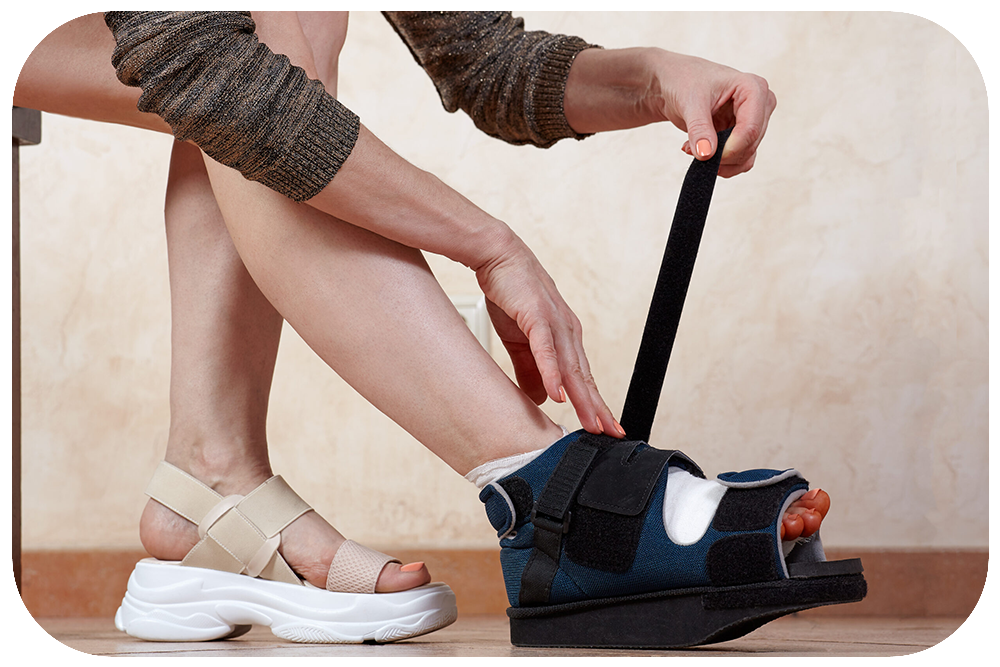
Bunion Treatment
Are you tired of the pain and discomfort caused by bunions? You’re not alone. Bunions, a common foot condition, affect millions of people every year. Fortunately, there are effective treatment options that can alleviate the pain and help restore your foot’s natural shape. At The Bunion Cure, we offer a revolutionary, minimally invasive treatment designed to provide relief from bunions without the long recovery time associated with traditional surgery.
What Is A Bunion?
A bunion, or hallux valgus, is a bony bump that forms at the joint at the base of your big toe. It occurs when the bones in the front part of your foot shift out of place, causing the tip of your big toe to lean towards the second toe. This misalignment forces the joint at the base of the big toe to protrude, resulting in a painful, swollen bump.
Bunions can cause a range of symptoms, including:
- Pain and tenderness around the affected joint.
- Redness and swelling on the side of the foot.
- Difficulty wearing shoes due to the pressure on the bunion.
- Stiffness and restricted movement in the big toe.
- Calluses or corns caused by overlapping toes.
While bunions can be linked to genetics, other factors like improper footwear, foot injuries, or conditions such as arthritis can contribute to their development.
The Limitations of Traditional Bunion Surgery
For years, traditional bunion surgery has been the go-to treatment for severe cases. However, this approach comes with significant downsides, including:
Given these challenges, many people seek an alternative solution that provides the same long-term results without the inconvenience and recovery time.
Introducing Minimally Invasive Bunion Treatment
At The Bunion Cure, we specialize in a minimally invasive approach to bunion correction, offering patients a faster, less painful option to traditional surgery. Our advanced procedure requires only small incisions, resulting in less tissue damage, minimal scarring, and a much quicker recovery.
This cutting-edge technique is designed to realign the bones in your foot and correct the underlying issue that causes the bunion. By using precise, minimally invasive techniques, we can achieve the same results as traditional surgery without the lengthy downtime.
How Minimally Invasive Bunion Surgery Works
Minimally invasive bunion surgery is performed through small incisions, typically less than five millimeters. These small openings allow your surgeon to use specialized instruments to correct the misaligned bones in the foot.
Here’s a breakdown of the procedure:
Because this procedure involves less tissue disruption, there is significantly less swelling, discomfort, and scarring compared to traditional surgery.
Benefits of Minimally Invasive Bunion Surgery
Minimally invasive bunion surgery offers numerous benefits over traditional procedures, making it an ideal option for patients seeking a quicker, less painful recovery.
Faster Recovery Time
One of the most significant advantages of our minimally invasive procedure is the reduced recovery time. Many patients can return to normal activities within a few weeks, as opposed to the months often required with traditional surgery. In fact, most patients can walk immediately after surgery, significantly reducing downtime and helping you get back to your daily routine more quickly.
Minimal Scarring
The small incisions used in minimally invasive surgery mean that patients are left with only tiny, barely noticeable scars. Traditional surgery often leaves larger, more visible scars that can be uncomfortable and unsightly. Our technique prioritizes both the function and appearance of your foot.
Reduced Pain and Swelling
Because this technique causes less trauma to the surrounding tissues, patients experience far less postoperative pain and swelling. This allows for a much more comfortable recovery experience and reduces the need for strong pain medications.
Immediate Weight-Bearing
With traditional surgery, patients are often required to stay off their feet for extended periods, using crutches or a walking boot. Our minimally invasive approach allows many patients to bear weight on their foot immediately after surgery, making it easier to resume normal activities faster.
High Success Rates
Minimally invasive bunion surgery has been shown to have excellent outcomes, with long-term relief from bunion pain and correction of the foot’s alignment. The precision of the technique leads to fewer complications and more predictable results.
Am I a Candidate for Minimally Invasive Bunion Surgery?
If you suffer from bunion pain that interferes with your daily life, you may be a candidate for minimally invasive bunion surgery. Ideal candidates are those who:
Bunion pain typically begins as mild discomfort but gets increasingly worse, especially when walking, standing, or wearing certain shoes, typically that are too narrow for your foot, for a long period of time. Although bunions are common and can be treated relatively easily with a proper diagnosis by a physician, they can cause intense pain in some cases, making it challenging for those affected to continue their regular daily activities. Bunion pain may also worsen at night, leading to difficulty sleeping due to severe discomfort. If left untreated, bunions can not only increase in pain but also raise the risk of further complications.
Self-diagnosing bunions can be tricky and is not reccomended. If you experience any of the symptoms mentioned above, it is important to contact your doctor promptly to determine if you have a bunion and to develop an appropriate treatment plan.
Types of Bunion Treatment
Bunion pain can be managed or treated using special tools and home remedies, which may include:
While these solutions can help alleviate pain, they do not completely treat bunions at their source. Over-the-counter solutions and medications may offer short-term pain relief for bunions, but they do not address the underlying issue—the imbalance of ligaments, tendons, and muscles in your foot. External treatments like bunion pads or splints can temporarily realign your toe, but the only way to truly restore balance is by repositioning these ligaments, tendons, and muscles, and realigning the big toe joint. Therefore, despite claims from companies selling at-home bunion correctors, these products are not effective long-term treatments and only provide temporary pain relief, potentially leading to further complications.
Some doctors recommend physical therapy or the long-term use of a cast or splint to relieve bunion pain. However, most bunions require surgery to permanently alleviate the patient’s pain.








